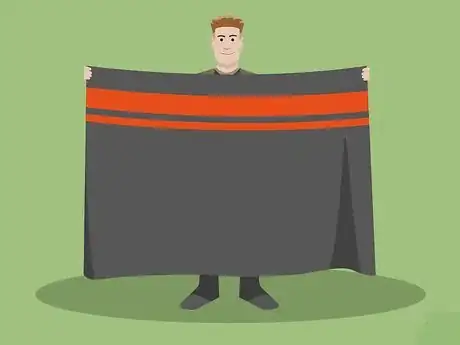This article was co-authored by wikiHow staff writer, Christopher M. Osborne, PhD. Christopher Osborne has been a wikiHow Content Creator since 2015. He is also a historian who holds a PhD from The University of Notre Dame and has taught at universities in and around Pittsburgh, PA. His scholarly publications and presentations focus on his research interests in early American history, but Chris also enjoys the challenges and rewards of writing wikiHow articles on a wide range of subjects.
There are 9 references cited in this article, which can be found at the bottom of the page.
This article has been viewed 32,871 times.
Learn more...
Infrared light, which is more accurately called infrared radiation (IR), creates the warmth you feel on your skin on a sunny day.[1] It’s also the basis for thermal imaging cameras, but there are several relatively simple methods you can use to at least partially block this type of IR, if desired. Alternatively, if you’re interested in blocking or filtering IR for photography, home efficiency, or possible health-related reasons, there are products available in these areas as well.
Steps
Blocking Thermal Imaging Camera IR
-
1Stay behind glass to remain invisible to thermal imagery IR. While some IR wavelengths do travel through glass, those utilized by thermal imaging cameras do not. This means you’re safe from thermal imagery “spying” when you’re inside your home or vehicle.[2]
- This also means you could carry around a pane of glass as an IR-blocking shield. However, a thermal imaging camera would clearly pick up the shape of the glass pane, so you wouldn't exactly blend into your surroundings!
-
2Cover yourself with a Mylar foil thermal blanket. These are the shiny silver blankets found in disaster kits, and they’re excellent at holding in heat. By blocking your body heat from escaping, the blanket makes those parts of your body covered by it practically invisible to a thermal imaging camera.[3]
- You can buy a tarp made of the same material and create a tent if you’re concerned about overhead thermal imaging cameras (such as on drones).
Advertisement -
3Use a wool blanket or insulated outerwear as more temporary options. These work on the same principle as the Mylar foil thermal blanket—they hold in your body heat and shield it from the thermal imaging camera. However, your body heat will eventually warm through the material and make it increasingly visible.
- It’s impossible to give good estimates as to how long different materials will conceal you, because there are simply too many variables to account for. You may only get a few minutes of concealment in some cases.
-
4Conceal yourself with thick netting that disperses your heat signature. Think here of the kind of netting you might see in a military scenario, with fake leaves and such attached to it to help it blend into the surrounding vegetation. While your body heat will pass through the netting to some extent, it will be “chopped up” into fragments that may be hard to identify as the outline of a person.
- This type of netting works best as a screen placed between you and the thermal imaging camera—you might stretch it overhead between several trees to help conceal your camp from drones, for instance.
- Shop for thick netting at outdoor sports retailers, military surplus stores, or online.
-
5Stand in front of a heat source that’s roughly body temperature. It’s the difference between your body temperature and the temperatures of the things surrounding you that makes you visible to a thermal imaging camera. Therefore, if you place yourself near large items that are close to your temperature, your heat signature will blend into your surroundings.
- For example, you might stand in front of a concrete block wall—or crouch in front of a boulder—that’s been heated by the sun all day.
-
6Test the IR-blocking advantages (and limitations) of emerging tech options. It may sound like science fiction, but there are scientists working on developing thin, flexible, IR-blocking “shields” that may some day be viable as clothing or blankets. Known as black silicon, one such product has a surface with microscopic etchings and spikes that help to diffuse and block IR penetration.[4]
- Don’t expect “invisibility cloaks” to hit the market anytime soon, though! And keep in mind that the cloak would only make you practically invisible to IR (such as thermal imaging cameras), not to the naked eye or night vision cameras.
Filtering IR for Photography, Heat Transfer, or Health
-
1Use your camera’s “IR-cut” to accurately reproduce daytime coloring. Modern cameras typically have an “IR-cutoff filter” (or “IR-cut”) installed between the lens and the image sensor. When the camera is in a daytime setting, the filter blocks out IR wavelengths that, while invisible to the human eye, are “visible” to the image sensor and can noticeably impact image coloration. Alternatively, in a nighttime setting, the filter is not used so that sufficient lighting (including IR wavelengths) can reach the image sensor.
- Most cameras use or avoid using the “IR-cut” automatically based on the settings, but you may be able to manually control its use as well—check your camera’s user guide. Not using the filter during daytime (or using it at night) can add intriguing color and lighting elements to your photography.
- IR-cutoff filters can also be purchased separately in some cases, especially for manual-advance SLR (single-lens reflex) film cameras.
-
2Combine IR film and color lens filters for unique photo effects. IR film, which captures IR wavelengths, is most easily tracked down online from specialty photography retailers. For dramatic and somewhat unpredictable effects, use it in an older, manual SLR camera along with your choice of color lens filter—such as orange, red, or dark red. Different filters, conditions, and techniques will produce photos with a range of IR effects.[5]
- IR film must be refrigerated and kept away from light while not in use. It also requires specialty developing procedures.
- Most modern SLR cameras—and especially those with manual-advance features—have sensors that are incompatible with IR film.
- Color lens filters are available online and at photography retailers.
-
3Invest in windows with specialized coatings to limit IR heat transfer. The warmth you feel near a sunny window is caused by IR penetrating the glass. While this may be welcome on a cold winter’s day, IR heating causes your air conditioner to work overtime during the summer. Most residential and commercial windows now have special coatings to reduce IR penetration, but keep an eye out for new developments such as the following:
- Tin oxide nanoparticles “doped” with antimony. This type of coating can significantly cut back on IR penetration.[6]
- Vanadium dioxide. This type of coating can essentially be turned “on” or “off” with a small electric charge, which means you can allow IR in during the winter but block much of it during the summer.[7]
-
4Ask your dermatologist before using IR-blocking cosmetics. IR-blocking products are a growing trend in the cosmetics industry, with some experts claiming that IR, like UV radiation, causes skin damage. However, the scientific backing for these claims is very thin, and there is some evidence that IR may actually be beneficial to your skin.[8]
- Your best option is to talk to your dermatologist. They’ll have better knowledge of the latest research on IR and can help guide your decision-making process.
- If you do choose to use IR-blocking cosmetics, it’s still very important to also wear sunscreen that blocks UVA and UVB rays.[9] Put the IR-blocking product on first, then the sunscreen.
-
5Chose IR-blocking sunglasses, if desired, but don’t buy the health claims. Many brands of sunglasses claim to block 90% or more of IR wavelengths, and some point out potential health benefits to this reduction. However, the vast majority of eye professionals believe there is no connection between IR exposure and eye health. So, while there’s no harm in using IR-blocking sunglasses, it’s also not worth paying extra for them.[10]
- If your eye care professional does in fact recommend IR-blocking sunglasses for eye health reasons, work with them to choose the brand and type most suited to your case. Or, if you’re skeptical, seek a second opinion from another eye professional.
References
- ↑ https://science.nasa.gov/ems/07_infraredwaves
- ↑ https://sciencing.com/materials-absorb-infrared-rays-8044395.html
- ↑ https://sciencing.com/materials-absorb-infrared-rays-8044395.html
- ↑ https://www.snexplores.org/article/heres-how-to-hide-some-objects-from-heat-sensing-cameras
- ↑ https://www.photoshopessentials.com/photo-effects/infrared-photo/
- ↑ https://www.sciencedaily.com/releases/2016/08/160825152054.htm
- ↑ https://phys.org/news/2013-11-vanadium-dioxide-smart-glass-block.html
- ↑ https://www.ncbi.nlm.nih.gov/pmc/articles/PMC4745411/
- ↑ https://www.cancer.org/healthy/be-safe-in-sun/uv-protection.html














-Electric-Shock-Step-9.webp)






















































